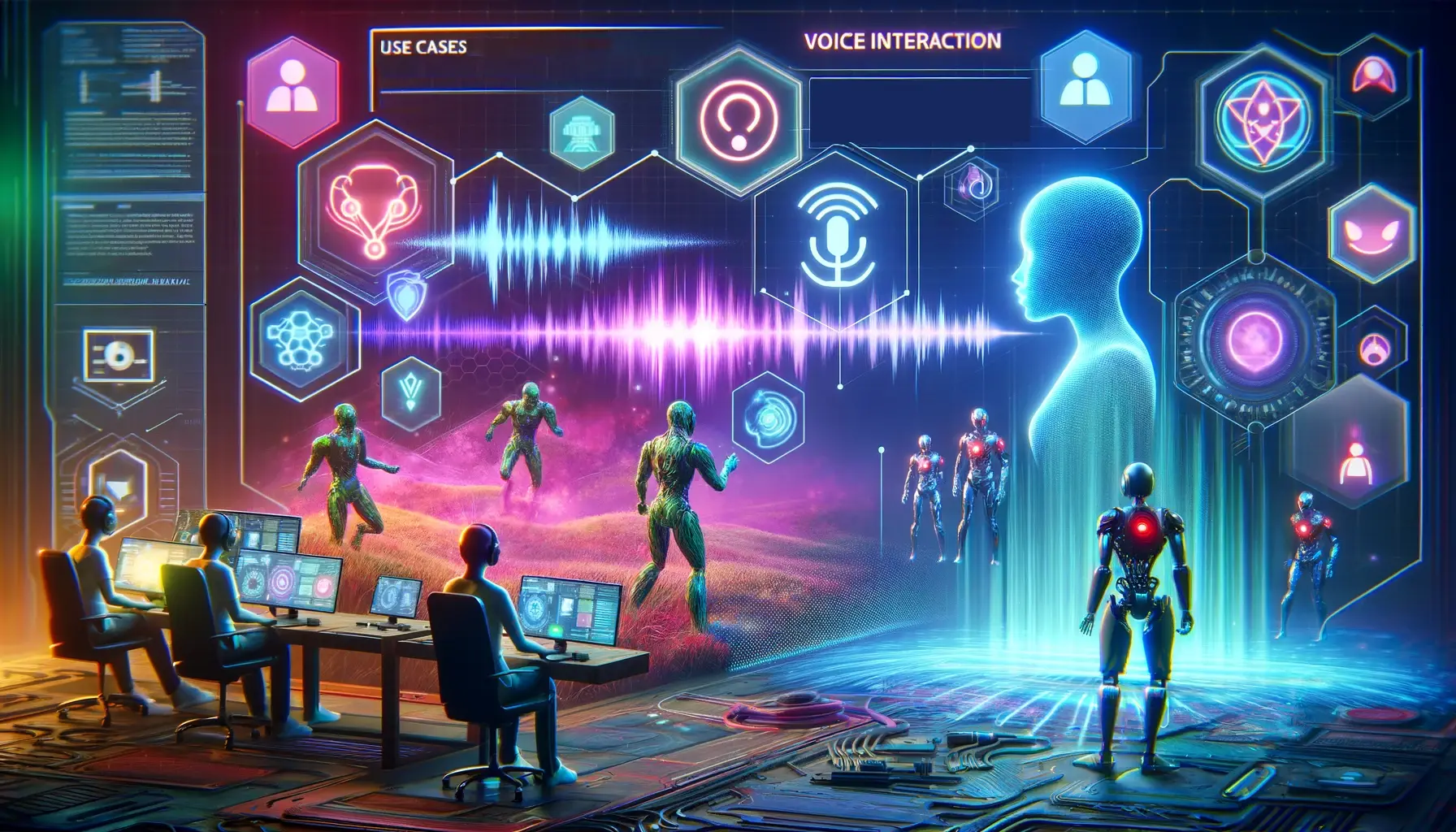Top 5 AI Use Cases In Gaming Voice Interaction
- By Matt

Attention Gaming Industry Professionals and AI Enthusiasts!
Encountering lackluster gameplay, disengaged players, and stagnant innovation are not distant threats but imminent realities for those who fail to integrate AI into gaming voice interaction strategies now.
In this article, we’ll reveal how AI can revolutionize voice interactions in gaming, helping you avoid these costly shortcomings.
Key Takeaways
- AI-enhanced dynamic voice responses provide context-sensitive reactions, improving player engagement.
- Procedural dialogue generation allows for varied and responsive gameplay experiences.
- AI-powered voice recognition enables natural speech commands, enhancing user interaction.
- Emotion detection in voice acting creates nuanced and engaging player interactions.
- Adaptive dialogue systems personalize the gaming experience based on player behavior.
Use Case #5: Adaptive Dialogue Systems
Starting our countdown at number 5 is the implementation of AI-driven adaptive dialogue systems, transforming player interactions and creating personalized experiences.
The Challenge of Static Conversations
Static, repetitive dialogues in games can disengage players and break immersion. Traditional dialogue systems lack the flexibility to adapt to player choices and behavior.
This rigidity in dialogues adds stress to game development, making it difficult to provide personalized experiences and retain player interest.
Impacts of Unadaptable Dialogue Systems
- Player disengagement
- Reduced immersion
- Decreased replayability
- Higher development costs for dialogue variety
How AI Enhances Dialogue Systems
AI-driven adaptive dialogue systems analyze player behavior and choices to tailor conversations in real-time. This dynamic approach creates more immersive and personalized interactions.
Implementing AI for adaptive dialogues ensures varied, engaging, and responsive gameplay experiences, keeping players hooked.
Table 1: Key Benefits of Adaptive Dialogue Systems
| Benefit | Description |
|---|---|
| Increased Immersion | Tailored dialogues enhance the game world |
| Improved Engagement | Dynamic conversations keep players interested |
| Enhanced Replayability | Varied interactions encourage multiple playthroughs |
| Cost Efficiency | Reduces the need for extensive manual dialogue writing |
Table 1 highlights the significant benefits of implementing adaptive dialogue systems in games.
Personalizing Player Experiences
AI-powered adaptive dialogue systems revolutionize the way players interact with game characters, ensuring unique and personalized experiences. This technology minimizes repetitive dialogues and enhances player engagement.
As AI continues to advance, adaptive dialogue systems will become even more sophisticated, further enriching player experiences and game replayability.
Use Case #4: Emotion Detection in Voice Acting
Leveraging AI to detect and respond to the emotional tone of the player’s voice creates more nuanced and engaging interactions.
The Difficulty of Static Voice Acting
Static voice acting can result in flat, unengaging interactions that fail to respond to the player’s emotional cues. This lack of dynamism reduces the overall immersion and impact of the game.
Emotionally unresponsive voice acting adds stress to the player experience, making it difficult to connect deeply with the game world.
Challenges in Emotion Detection
- Monotone interactions
- Reduced player immersion
- Less impactful storytelling
- Difficulty in emotional engagement
AI-Driven Emotion Detection
AI-driven emotion detection analyzes the player’s voice to adapt the game’s voice acting in real-time. This ensures that character responses match the player’s emotional state, creating a more immersive experience.
Implementing AI for emotion detection enhances player immersion and emotional engagement, making interactions more impactful and personal.
Table 2: Key Benefits of Emotion Detection in Voice Acting
| Benefit | Description |
|---|---|
| Improved Immersion | Emotionally responsive interactions enhance engagement |
| Enhanced Storytelling | Dynamic voice acting makes stories more impactful |
| Increased Player Connection | Emotional responses foster deeper player connections |
| Personalized Interactions | Adaptation to player emotions personalizes the experience |
Table 2 outlines the benefits of AI-driven emotion detection in voice acting for games.
Enhancing Emotional Engagement
AI-powered emotion detection transforms voice acting in games, ensuring that character interactions are emotionally responsive and engaging. This technology enhances storytelling and player immersion.
As AI continues to evolve, emotion detection systems will become even more accurate, further enriching the emotional depth of player interactions.
Use Case #3: Procedural Dialogue Generation
Utilizing AI to generate dialogues on the fly provides a more varied and responsive gaming experience.
The Limitation of Pre-Written Dialogues
Pre-written dialogues can limit the variety and responsiveness of interactions in games. Players may encounter repetitive lines that detract from the immersion and engagement.
This limitation in dialogue generation adds stress to the development process, as creating extensive dialogue trees manually is time-consuming and costly.
Challenges in Dialogue Generation
- Repetitive interactions
- Limited dialogue variety
- High development costs
- Reduced player engagement
AI-Driven Procedural Dialogue
AI-driven procedural dialogue systems generate conversations dynamically based on context and player actions. This approach ensures varied and responsive interactions, enhancing the overall gaming experience.
Implementing AI for procedural dialogue generation reduces repetitive interactions and development costs, while boosting player engagement.
Table 3: Key Benefits of Procedural Dialogue Generation
| Benefit | Description |
|---|---|
| Increased Variety | Dynamically generated dialogues enhance interactions |
| Improved Engagement | Responsive dialogues keep players invested |
| Cost Efficiency | Reduces the need for extensive manual dialogue writing |
| Enhanced Replayability | Varied dialogues encourage multiple playthroughs |
Table 3 highlights the significant benefits of procedural dialogue generation in games.
Creating Varied Interactions
AI-driven procedural dialogue generation revolutionizes the way dialogues are created in games, ensuring that interactions are varied and responsive. This technology minimizes repetitive conversations and enhances player engagement.
As AI continues to advance, procedural dialogue systems will become even more sophisticated, further enriching player experiences and game replayability.
Use Case #2: Voice Recognition for Commands
Leveraging AI-powered voice recognition allows players to control the game and interact with characters using natural speech, enhancing the user experience.
The Challenge of Traditional Controls
Traditional control schemes can be limiting and unintuitive, especially in complex games. Players may struggle to remember button combinations or navigate menus efficiently.
This challenge in control schemes adds stress to the gameplay experience, reducing accessibility and immersion for players.
Impacts of Complex Controls
- Reduced accessibility
- Player frustration
- Lower immersion
- Decreased enjoyment
AI-Driven Voice Recognition
AI-powered voice recognition systems enable players to use natural speech to issue commands and interact with the game. This intuitive control method enhances accessibility and immersion, making gameplay more enjoyable.
Implementing AI for voice recognition improves user experience by providing a seamless and intuitive way to control the game.
Table 4: Key Benefits of Voice Recognition for Commands
| Benefit | Description |
|---|---|
| Increased Accessibility | Natural speech controls make games easier to play |
| Enhanced Immersion | Voice commands provide a more immersive experience |
| Reduced Frustration | Intuitive controls minimize player frustration |
| Improved Enjoyment | Simplified controls enhance overall gameplay |
Table 4 outlines the benefits of AI-driven voice recognition in gaming.
Streamlining Game Controls
AI-powered voice recognition transforms game controls by enabling natural speech commands, enhancing accessibility and immersion. This technology reduces player frustration and makes gameplay more intuitive.
As AI continues to evolve, voice recognition systems will become even more accurate and responsive, further enhancing the user experience in gaming.
Use Case #1: Dynamic Voice Responses
Utilizing AI for dynamic voice responses provides context-sensitive reactions to player actions and choices, creating a more engaging and immersive gaming experience.
The Limitations of Pre-Recorded Responses
Pre-recorded responses in games can feel repetitive and unresponsive, breaking immersion and reducing player engagement. These static interactions fail to adapt to the dynamic nature of gameplay.
This limitation in voice responses adds stress to the player experience, making it difficult to maintain immersion and interest.
Impacts of Static Voice Responses
- Player disengagement
- Reduced immersion
- Lowered replayability
- Less impactful interactions
AI-Driven Dynamic Voice Responses
AI-driven dynamic voice response systems analyze the context of player actions and choices to generate appropriate reactions in real-time. This ensures that character responses are varied and immersive.
Implementing AI for dynamic voice responses enhances player engagement by providing context-sensitive interactions that keep the game world alive and responsive.
Table 5: Key Benefits of Dynamic Voice Responses
| Benefit | Description |
|---|---|
| Increased Engagement | Context-sensitive responses keep players immersed |
| Enhanced Immersion | Dynamic interactions make the game world feel alive |
| Improved Replayability | Varied responses encourage multiple playthroughs |
| More Impactful Interactions | Adaptive responses make interactions more meaningful |
Table 5 highlights the significant benefits of implementing dynamic voice responses in games.
Enhancing Interaction Dynamics
AI-driven dynamic voice responses revolutionize player interactions by providing context-sensitive reactions. This technology ensures that character responses are varied and engaging, enhancing immersion and replayability.
As AI continues to advance, dynamic voice response systems will become even more sophisticated, further enriching player interactions and game experiences.
Conclusion
In the rapidly evolving gaming industry, static interactions, disengaged players, and outdated technology present significant threats to your success.
Neglecting to integrate these advanced AI systems means missing out on opportunities for enhanced engagement, dynamic interactions, and a more immersive gaming experience.
Latest Posts
- By Matt | 1 year ago
- By Matt | 2 years ago
- By Matt | 2 years ago
- By Matt | 2 years ago
- By Matt | 2 years ago
- By Matt | 2 years ago
- By Matt | 2 years ago
There are no results matching your search
Trending
There are no results matching your search






